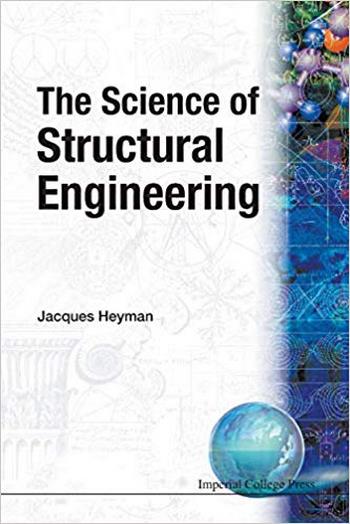نام کتاب: The Science of Structural Engineering
نویسنده: Jacques Heyman
ویرایش: ۱
سال انتشار: ۱۹۹۹
فرمت: PDF
تعداد صفحه: ۱۲۰
کیفیت کتاب: OCR
انتشارات: Imperial College
Description About Book The Science of Structural Engineering From Amazon
Structures cannot be created without engineering theory, and design rules have existed from the earliest times for building Greek temples, Roman aqueducts and Gothic cathedrals — and later, for steel skyscrapers and the frames for aircraft. This book is, however, not concerned with the description of historical feats, but with the way the structural engineer sets about his business. Galileo, in the seventeenth century, was the first to introduce recognizably modern science into the calculation of structures; he determined the breaking strength of beams. In the eighteenth century engineers moved away from this ‘ultimate load’ approach, and early in the nineteenth century a formal philosophy of design had been established — a structure should remain elastic, with a safety factor on stress built into the analysis.
This philosophy held sway for over a century, until the first tests on real structures showed that the stresses confidently calculated by designers could not actually be measured in practice. Structural engineering has taken a completely different path since the middle of the twentieth century; plastic analysis reverts to Galileo’s objective of the calculation of ultimate strength, and powerful new theorems now underpin the activities of the structural engineer.This book deals with a technical subject, but the presentation is completely non-mathematical. It makes available to the engineer, the architect and the general reader the principles of structural design.
درباره کتاب The Science of Structural Engineering – ترجمه شده از گوگل
سازه ها نمی توانند بدون تئوری مهندسی ایجاد شوند و از زمان های اولیه برای ساخت معابد یونانی، آبشارهای رومی و کلیساهای گوتیک – و بعد از آن برای آسمان خراش های فولادی و فریم های هواپیما وجود داشته است. با این حال، این کتاب مربوط به توصیف روحیه های تاریخی نیست، بلکه همانطور که مهندس ساخت و ساز در مورد کسب و کارش می گوید. گالیله در قرن هفدهم اولین کسی بود که علم مدرن را به طور قابل توجهی در محاسبه ساختارها معرفی کرد؛ او قدرت شکستن پرتوها را تعیین کرد. در قرن هجدهم، مهندسین از رویکرد “بار نهایی” دور شدند، و در اوایل قرن نوزدهم، یک فلسفه رسمی طراحی تاسیس شد – ساختار باید با الاستیسیته با فاکتور ایمنی در استرس ساخته شده در تحلیل تجزیه و تحلیل شود.
این فلسفه بیش از یک قرن تحت تأثیر قرار گرفت، تا زمانی که نخستین آزمایش ها بر روی ساختارهای واقعی نشان داد که تنش ها با اطمینان محاسبه شده توسط طراحان را نمی توان در عمل اندازه گیری کرد. مهندسی سازه از اواسط قرن بیستم یک مسیر کاملا متفاوت را طی کرده است؛ تجزیه و تحلیل پلاستیکی به هدف گالیله برای محاسبه قدرت نهایی باز میگردد و قضیه جدید قدرتمند اکنون فعالیت مهندس سازه را پایه ریزی میکند. این کتاب به موضوع فنی مربوط میشود، اما ارائه کاملا غیر ریاضی است. این باعث می شود مهندس، معمار و خواننده عمومی اصول طراحی ساختاری را در اختیار شما قرار دهد.
[box type=”info”]![]() جهت دسترسی به توضیحات این کتاب در Amazon اینجا کلیک کنید.
جهت دسترسی به توضیحات این کتاب در Amazon اینجا کلیک کنید.![]() در صورت خراب بودن لینک کتاب، در قسمت نظرات همین مطلب گزارش دهید.
در صورت خراب بودن لینک کتاب، در قسمت نظرات همین مطلب گزارش دهید.

